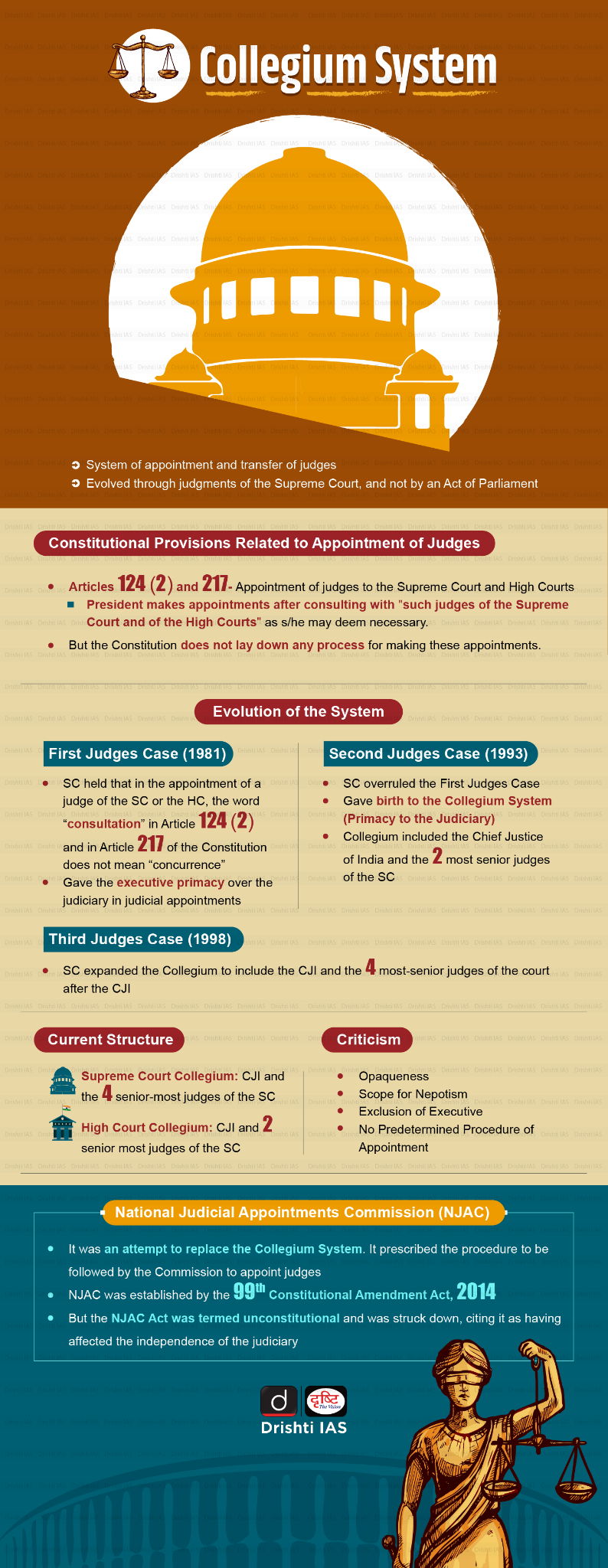Indian Polity
Judicial Transfers and In-House Inquiry
- 25 Mar 2025
- 8 min read
For Prelims: Collegium System, In-house inquiry procedure, Chief Justice of India
For Mains: Judicial Transfers in India, Comparison between In-House Inquiry and Impeachment Process, Judicial Ethics and Integrity
Why in News?
The Supreme Court (SC) Collegium has recommended the transfer of Delhi High Court Judge (Justice Yashwant Varma) to the Allahabad High Court. This decision comes in the wake of allegations regarding the discovery of “sacks of burnt currency” at his residence.
- Simultaneously, an in-house inquiry procedure was initiated by Chief Justice of India (CJI) Sanjiv Khanna to conduct a deeper investigation into the incident.
- The move upholds the Restatement of Values of Judicial Life, ensuring judicial integrity, and accountability.
What is the Process of Judicial Transfers in India?
- Constitutional Provision: Article 222 of Indian Constitution empowers the President, based on the recommendation of the CJI, to transfer a judge (including Chief Justice) from one High Court to another.
- Consent of the judge is not required, whether it is the first or a subsequent transfer.
- Role of the CJI and the Collegium: The CJI initiates the transfer proposal and his opinion is determinative.
- For transferring a Judge (not Chief Justice), the CJI consults the Chief Justice of the transferring High Court and the receiving High Court and considers input from one or more SC judges who know the concerned judge’s performance.
- For transferring a Chief Justice, the proposal is reviewed by the CJI along with the four senior-most judges of the Supreme Court, collectively forming the Collegium.
- In making the final decision, the Collegium also considers personal aspects of the judge, like health conditions, and location preferences.
- Role of the Executive: The Union Law Minister forwards the Collegium’s recommendation to the Prime Minister, who advises the President to approve the transfer.
- Upon approval, the Department of Justice notifies the transfer in the Gazette of India, and the Chief Justices and Chief Ministers of the concerned states are informed.
- Importance of Transfers: Help in optimizing judicial efficiency across High Courts by balancing workload and expertise.
- Prevents undue influence or bias that may arise from prolonged tenure and helps to preserve public trust by addressing concerns about impartiality and judicial misconduct.
What is an In-House Inquiry?
- In-House Inquiry: The Supreme Court introduced an in-house inquiry procedure in 1999. This was prompted by the C. Ravichandran Iyer v. Justice A.M. Bhattacharjee case (1995), which exposed the absence of a mechanism to deal with judicial misconduct falling below the impeachment (Article 124 and 218 of the Constitution) threshold.
- A five-member committee proposed the in-house Inquiry framework in 1997, which was formally adopted in 1999.
- The procedure was reaffirmed and detailed in Additional District and Sessions Judge 'X' vs Registrar General, Madhya Pradesh HC (2014), detailed out internal process for judicial inquiries.
- Procedure: The in-house inquiry process begins when a complaint against a judge is received by the CJI, a High Court Chief Justice, or the President, it need not originate from Parliament.
- If found credible, the CJI may ask the concerned High Court CJ to conduct a preliminary inquiry.
- Based on this report, if deeper investigation is needed, the CJI constitutes a three-member committee (two Chief Justices and one High Court judge).
- The committee conducts the inquiry while ensuring natural justice, allowing the judge to respond. The final report submitted to the CJI must state whether the allegations are substantiated and if they warrant removal.
- If the misconduct is minor, the judge may be warned or advised, and the report kept confidential ( but placed on record).
- If serious misconduct is established, the judge may be asked to resign or retire.
- Upon refusal, the judge may be relieved of judicial duties, and if necessary, the CJI may recommend impeachment.
What is Restatement of Values of Judicial Life?Click here to Read: Restatement of Values of Judicial Life |
In-House Inquiry Vs. Constitutional Impeachment
|
Aspect |
In-House Inquiry Mechanism |
Constitutional Impeachment |
|
Basis |
Based on Supreme Court resolutions (1999) |
Article 124(4) (removal of Supreme Court judge) & 218 of the Constitution (removal of High Court judges) |
|
Applicability |
Judicial misconduct below impeachment threshold |
Only for “proved misbehaviour or incapacity” |
|
Initiated by |
CJI, High Court Chief Justice, or President |
Members of Parliament |
|
Process Type |
Internal, confidential judicial mechanism |
Parliamentary and public process |
|
Outcome |
Advice, warning, or recommendation for resignation/retirement |
Removal from office by Presidential order |
|
Role of Parliament |
No involvement |
Requires 2/3rd majority in both Houses |
|
Transparency |
Confidential process to protect judicial dignity |
Public and media-visible process |
|
Final Authority |
Chief Justice of India |
President of India (on PM’s advice after Parliament vote) |
|
Drishti Mains Question: What is the in-house inquiry procedure for judges in India? How does it address judicial misconduct? |
UPSC Civil Services Examination, Previous Year Question (PYQ)
Prelims
Q. With reference to the Indian judiciary, consider the following statements: (2021)
- Any retired judge of the Supreme Court of India can be called back to sit and act as a Supreme Court judge by the Chief Justice of India with the prior permission of the President of India.
- A High Court in India has the power to review its own judgement as the Supreme Court does.
Which of the statements given above is/are correct?
(a) 1 only
(b) 2 only
(c) Both 1 and 2
(d) Neither I nor 2
Ans: (c)
Mains
Q.Critically examine the Supreme Court’s judgement on ‘National Judicial Appointments Commission Act, 2014’ with reference to appointment of judges of higher judiciary in India. (2017)





